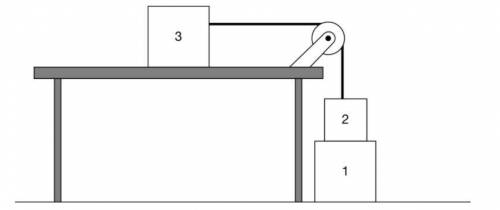
This question is a long free-response question. Show your work for each part of the question.
The figure presents a diagram of three blocks, labeled 1 through 3. In the diagram, block 1 is resting on the floor. Block 2, which is smaller than block 1, is resting on top of block 1. Block 3, which is approximately the same size as block 1, is resting on a table. The right side of block 3 is attached to one end of a string which runs over a pulley located at the right edge of the table. The other end of the string is attached to the top of block 2.
Block 1 is resting on the floor with block 2 at rest on top of it. Block 3, at rest on a smooth table with negligible friction, is attached to block 2 by a string that passes over a pulley, as shown above. The string and pulley have negligible mass.
(a)
i. On the dot that represents block 1, draw and label the forces (not components) exerted on block 1. Each force must be represented by a distinct arrow starting on, and pointing away from, the dot. Draw the relative lengths of all arrows to reflect the relative magnitudes of the forces.
The figure presents a 6 by 6 grid with a dot in the center, labeled “Block 1.”
Question 2
ii. On the dot that represents block 2, draw and label the forces (not components) exerted on block 2. Each force must be represented by a distinct arrow starting on, and pointing away from, the dot. Draw the relative lengths of all arrows to reflect the relative magnitudes of the forces.
The figure presents a 6 by 6 grid with a dot in the center, labeled “Block 2.”
Question 3
(b) Block 1 is removed without disturbing block 2.
i. Consider the scenario where the mass m3 of block 3 is greater than the mass m2 of block 2. Without using equations, make a claim about the motion of block 3 in terms of balanced or unbalanced forces.
Block 3 will move to the right because friction is negligible so Fg would move block 2 down and therefore, tension would pull block 3.
Question 4
ii. Derive an equation for the acceleration of block 3 for any arbitrary values of m3 and m2. Express your answer in terms of m3, m2, and physical constants as appropriate.
Question 5
(c) Describe in what way your answer to part (b)(ii) is or is not consistent with your claim in part (b)(i).
It is consistent with bi because the block3 will be moving to the right.
Question 6
(d) On the axes below, sketch graphs of the velocity and the acceleration of block 2 after block 1 has been removed. Take the time to be zero immediately after block 1 has been removed.
Please help I have a test tmr


Answers: 2
Another question on Physics

Physics, 22.06.2019 02:30
Mass (kg) force (n) 5 25 10 50 15 75 20 100 a student was trying to find the relationship between mass and force. he placed four different masses on a table and pulled them using a spring scale. the table shows the different masses used in the experiment and the force required to pull each mass. the student concluded that more force was required to pull heavier objects. what comment would you make regarding his conclusion? a) no clear relation can be observed between mass and force from the data. b) there is a direct proportion between the mass and force listed in the table. c) gravity should have been taken into account while performing the experiment. d) there is an inverse proportion between the mass and force listed in the table.
Answers: 2

Physics, 22.06.2019 03:00
Which law represents the thermodynamic statement of the conservation of energy of a system? a. the fourth law b. the first law c. the second law d. the third law
Answers: 2

Physics, 22.06.2019 15:30
Identify the correct relation showing that the radius r of the orbit of a moon of a given planet can be determined from the radius r of the planet, the acceleration of gravity at the surface of the planet, and the time τ required by the moon to complete one full revolution about the planet. determine the acceleration of gravity at the surface of the planet jupiter knowing that r = 71 492 km and that t= 3.551 days and r= 670.9 × 10^3 km for its moon europa.
Answers: 2

Physics, 22.06.2019 19:40
It may seem strange that the selected velocity does not depend on either the mass or the charge of the particle. (for example, would the velocity of a neutral particle be selected by passage through this device? ) the explanation of this is that the mass and the charge control the resolution of the device--particles with the wrong velocity will be accelerated away from the straight line and will not pass through the exit slit. if the acceleration depends strongly on the velocity, then particles with just slightly wrong velocities will feel a substantial transverse acceleration and will not exit the selector. because the acc
Answers: 1
You know the right answer?
This question is a long free-response question. Show your work for each part of the question.
The f...
Questions

Spanish, 02.09.2019 09:00

History, 02.09.2019 09:00




Mathematics, 02.09.2019 09:00


Biology, 02.09.2019 09:00

Biology, 02.09.2019 09:00




Mathematics, 02.09.2019 09:00


Chemistry, 02.09.2019 09:00


English, 02.09.2019 09:00


English, 02.09.2019 09:00

Physics, 02.09.2019 09:00




